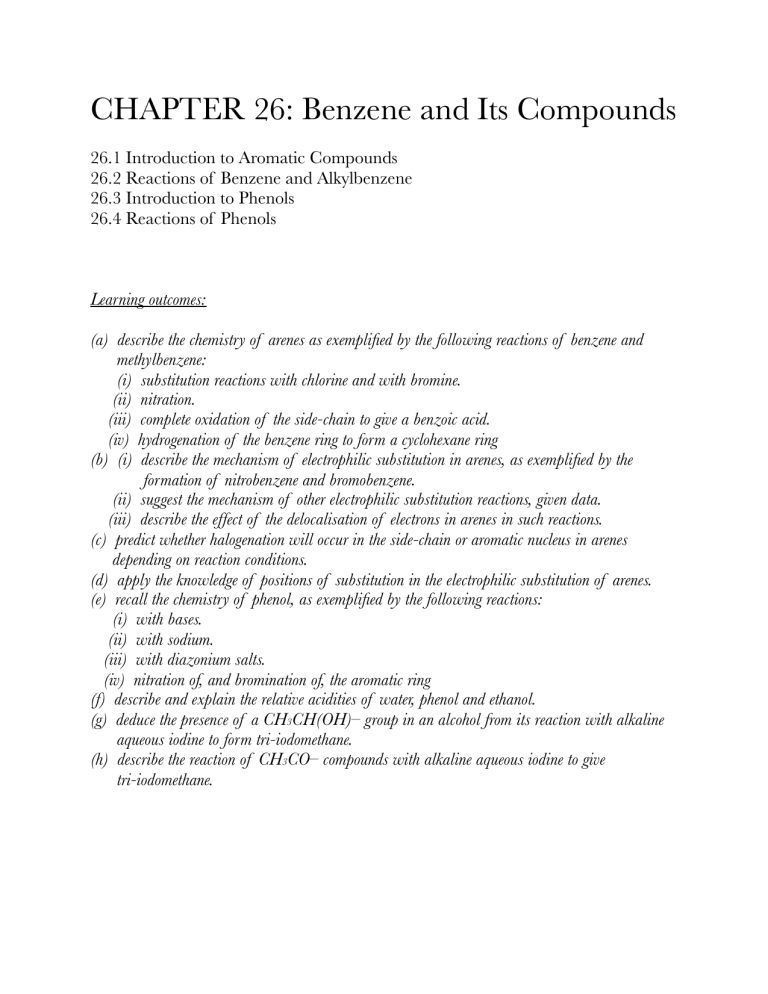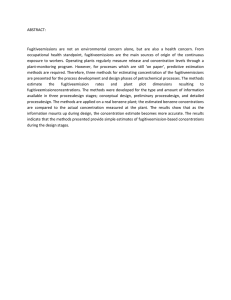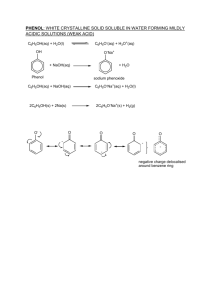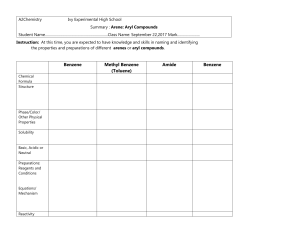
CHAPTER 26: Benzene and Its Compounds 26.1 Introduction to Aromatic Compounds 26.2 Reactions of Benzene and Alkylbenzene 26.3 Introduction to Phenols 26.4 Reactions of Phenols Learning outcomes: (a) describe the chemistry of arenes as exemplified by the following reactions of benzene and methylbenzene: (i) substitution reactions with chlorine and with bromine. (ii) nitration. (iii) complete oxidation of the side-chain to give a benzoic acid. (iv) hydrogenation of the benzene ring to form a cyclohexane ring (b) (i) describe the mechanism of electrophilic substitution in arenes, as exemplified by the formation of nitrobenzene and bromobenzene. (ii) suggest the mechanism of other electrophilic substitution reactions, given data. (iii) describe the effect of the delocalisation of electrons in arenes in such reactions. (c) predict whether halogenation will occur in the side-chain or aromatic nucleus in arenes depending on reaction conditions. (d) apply the knowledge of positions of substitution in the electrophilic substitution of arenes. (e) recall the chemistry of phenol, as exemplified by the following reactions: (i) with bases. (ii) with sodium. (iii) with diazonium salts. (iv) nitration of, and bromination of, the aromatic ring (f) describe and explain the relative acidities of water, phenol and ethanol. (g) deduce the presence of a CH3CH(OH)– group in an alcohol from its reaction with alkaline aqueous iodine to form tri-iodomethane. (h) describe the reaction of CH3CO– compounds with alkaline aqueous iodine to give tri-iodomethane. 26.1 Introduction to Aromatic Compounds Aliphatic and aromatic compounds 1) i. Aliphatic compounds are organic compounds that have carbon atoms joined together in straight chains, branched chains or non-aromatic rings. ii. Aromatic compounds are organic compounds that contain one or more benzene ring(in A-level). Examples of aromatic compounds: The structure of benzene 1) Benzene is a hexagonal and planar molecule with the formula C6H6. 2) In benzene, each carbon atom undergoes sp² hybridisation to give three hybrid orbitals and an unchanged p orbital which is perpendicular to the plane containing the three hybrid orbitals. 3) Two of the hybrid orbitals overlap with two other hybrid orbitals of carbon atoms and the other overlaps with the orbital of hydrogen. The unchanged p orbitals overlap with one another via a system of π bond to give a giant molecular orbital. This orbital is above and below the plane containing the carbon atoms. 4) The six electrons from each p orbital are then delocalised around the ring. A delocalised electron does not belong to any carbon atom. This delocalisation of electrons gives benzene a relatively stable structure. 5) In a benzene molecule, all the C-C bonds are identical, with a bond length of 140 pm. This bond length is longer than a double bond but shorter than a single bond. The bond angle between carbon atoms is 120º. 6) The stability of benzene is shown in its reluctance to undergo addition reactions. This is because when electrons are added, the delocalisation will be broken and so does the stability. 7) There are two common symbols for benzene, the right one is generally preferred over the left one because it indicates that the electrons are delocalised. 8) Before this modern structure was discovered, the Kekulé structure(right) was used. However, the Kekulé structure could not account for the unexplained properties of benzene. i. The structure has three double bonds, so it should undergo addition reactions like other alkenes do. However for real benzene, it does not undergo addition reactions easily. ii. Single and double bonds have different bond length, therefore Kekulé's benzene should have a distorted hexagonal shape. However in real benzene, all the C-C bonds are identical and it is a perfect hexagon. Introduction to arenes 1) Arenes are aromatic hydrocarbons, that is, hydrocarbon that contains at least one benzene ring. 2) Arenes have higher melting and boiling points than aliphatic hydrocarbons. i. This is because in aromatic hydrocarbons, temporary dipoles can be easily set up between the delocalised electrons. Hence the van der Waals' forces are stronger. ii. Benzenes with side chains also have permanent dipole forces between them. This is because the presence of side chains makes them a polar molecule. 26.2 Reactions of Benzene and Alkylbenzene Reactivity of benzene 1) Unlike alkenes, benzene is resistant to addition reactions. This is because it involves breaking the delocalised electron system and thus losing its stability. 2) Instead, benzene undergoes substitution reactions. This involves replacing one or more hydrogen atoms with another group of atoms. 3) Benzene is particularly attractive to electrophiles due to its high electron density. Therefore benzene mainly undergoes electrophilic substitution. 4) The reactivity of benzene is also affected by the presence of other group(s) in the benzene ring. This is known as substituent group effect, and it will be explained later. Electrophilic substitution 1) Electrophilic substitution is the replacement of an atom or a group of atom by an electrophile. In benzene, the electrophile replaces the hydrogen atom(s). 2) The general mechanism of electrophilic substitution: i. Suppose, an electrophile X⁺ is generated from a compound XY. The electrophile is attracted to the electron-rich region of the benzene ring. ii. Two electrons from the delocalised electron system are used to form a co-ordinate bond with the electrophile. iii. An intermediate with the delocalised electron system partially broken is formed. iv. Y⁻ ion, from XY has a lone pair of electrons on it and it forms a bond with the hydrogen ion. The hydrogen loses its electrons to the delocalised electron system to bond with Y⁻. The delocalised electron system is now restored. 3) Summary of reactions that benzene and alkylbenzene undergoes: i. Halogenation(addition of halogen) into the ring and side chain. ii. Nitration(addition of nitro group, NO2). iii. Oxidation of side chain. iv. Hydrogenation. Reaction of benzene - halogenation 1) Reagent : Chlorine/bromine gas, Cl2/Br2 Condition : Aluminium chloride, AlCl3 or iron(III) chloride, FeCl3 Product : Halobenzene 2) Benzene reacts with chlorine/bromine in the presence of halogen carriers such as aluminium chloride, AlCl3 to form chloro- or bromobenzene, respectively. One hydrogen atom in the benzene ring is substituted by the halogen. 3) Use chlorine as an example of halogen: C6H6 + Cl2 → C6H5Cl + HCl 4) The mechanism of this reaction - electrophilic substitution. i. Aluminium chloride polarises the Cl-Cl bond to create the electrophile Cl⁺. Cl2 + AlCl3 → Cl⁺ + AlCl4⁻ ii. The electrophile is attracted to the benzene, it then bonds with the benzene using two electrons from the delocalised electron system. Note that the delocalised electron system is partially broken in the intermediate. iii. A hydrogen ion is expelled from the ring by AlCl4⁻ and leaving its electrons in the ring. The delocalised electron system is now restored. Steamy fumes of hydrogen chloride is also observed. Reaction of benzene - nitration 1) Reagent : Concentrated nitric acid, HNO3 Condition : Reflux at a temperature lower than 50 ºC and the presence of concentrated sulfuric acid, H2SO4 as catalyst Product : Nitrobenzene 2) Nitration happens when one or more hydrogen atoms in benzene is replaced by a nitro group, NO2. 3) Benzene reacts with nitric acid in the presence of concentrated sulfuric acid to give nitrobenzene. C6H6 + HNO3 → C6H5NO2 + H2O 4) The mechanism of this reaction - electrophilic substitution. i. The electrophile, nitronium ion, NO2⁺ is formed by the reaction of nitric acid and sulfuric acid. HNO3 + 2H2SO4 → NO2⁺ + 2HSO4⁻ + H3O⁺ ii. As before, the electrophile is attracted to the benzene ring and forms a bond with it. The delocalised electron system is partially broken. iii. Hydrogen ion is expelled and it bonds with HSO4⁻ to regenerate the catalyst. The delocalised electron system is restored. 5) If the temperature exceeds 50 ºC, 1,3-dinitrobenzene will be formed as well. Notice that the second nitro group is added to the 3 position of the ring. Substituent group effect 1) If a benzene already has a first substituent in it, second incoming substituent is affected by the nature of the first substituent. 2) The first substituent has an effect on: i. the position of the incoming second substituent. - If X is an electron-withdrawing group, it deactivates the ring and it is 3-directing. - Examples are -NO2, -CN, -COOH, -CHO and -COR. - If X is an electron-donating group, it activates the ring and it is 2,4-directing. - Examples are -OH, -NH2, -C6H5 and alkyl groups. - The only exception are halogens, they are electron-withdrawing but they are 2,4-directing. ii. the rate at which the second substituent is introduced. - If X is an electron-withdrawing group, it deactivates the ring and the rate of reaction decreases - If X is an electron-donating group, it activates the ring and the rate of reaction increases. Reaction of alkylbenzene - halogenation 1) Reagent : Chlorine/bromine gas, Cl2/Br2 Condition : Into the ring - Aluminium chloride, AlCl3 or iron(III) chloride, FeCl3 as catalyst, absence of UV light Into the alkyl group - Absence of catalyst but presence of UV light Product : Halo-alkylbenzene 2) In the presence of halogen carriers and the absence of UV light at room temperature, the halogen is substituted into the ring via electrophilic substitution. 3) Take methylbenzene as an example, since methyl group is electron-donating and 2,4-directing, the incoming halogen is substituted at the 2 or 4 position. 2-chloro and 4-chloromethylbenzene are produced. C6H5CH3 + Cl2 → C6H4ClCH3 + HCl 4) In the presence of UV light and the absence of halogen carriers, the halogen is substituted into the alkyl group via free-radical substitution. Take methylbenzene as an example, (chloromethyl)benzene is produced. C6H5CH3 + Cl2 → C6H4(CH3Cl) + HCl 5) Further substitutions are possible, producing (dichloromethyl)benzene and (trichloromethyl)benzene. Reaction of alkylbenzene - nitration 1) Reagent : Concentrated nitric acid, HNO3 Condition : Reflux at a temperature lower than 30 ºC and the presence of concentrated sulfuric acid, H2SO4 as catalyst Product : Nitro-alkylbenzene 2) Since methyl group activates the ring, making the ring more reactive, the temperature has to be lowered to 30 ºC to prevent multiple substitutions. 3) Methyl group is an electron-donating group, it activates the ring and is 2,4-directing, therefore the nitro group is substituted at the 2 or 4 positions 4) Take methylbenzene as an example, 2-nitro and 4-nitromethylbenzene is produced. 5) If the temperature exceeds 30 ºC, multiple substitutions by nitro groups is possible. However, each time a nitro group substitutes, the rate of reaction of the next substitution decreases because nitro group is electron-withdrawing. Therefore, 2,4,6-trinitromethylbenzene is rare. Reaction of alkylbenzene - oxidation 1) Reagent : Acidified potassium manganate(VII), KMnO4 Condition : Heat or reflux Product : Benzoic acid 2) When methylbenzene is heated under reflux with acidified potassium manganate(VII), side-chain oxidation occurs. Benzoic acid is produced. 3) Any carbon side-chain group is oxidised to -COOH group under these conditions. Reaction of alkylbenzene - hydrogenation 1) Reagent : Hydrogen gas, H2 Condition : Heat in the presence of nickel, Ni catalyst at 150 °C Product : Cyclohexanes 2) In hydrogenation, hydrogen atoms are added to the benzene ring. The delocalised electron system is permanently broken. 3) With benzene: 4) With methylbenzene: 26.3 Introduction to Phenols What are phenols? 1) Phenols are benzene compounds which have an -OH group attached directly to it. 2) In a phenol molecule, one of the lone pairs on the oxygen overlaps with the delocalised electron system to give a structure like this: 3) This increases the electron density of the delocalised electron system. It makes phenols much more reactive than benzene itself. Also, it increases the acidity of phenol as well. 4) Physical properties of phenols: i. Phenol has a higher melting and boiling points than methylbenzene. - This is because phenols can form hydrogen bonds between them in addition of van der Waals' forces and permanent dipole-dipole forces. ii. Phenol itself is more soluble in water than other phenols. - This is because a small phenol molecule can form more effective hydrogen bonds with water molecules. - However, most phenols are generally insoluble in water. Acidity of phenols 1) Compounds like alcohols and phenols which contain an -OH group attached to a hydrocarbon are very weak acids. 2) Alcohol's strength as an acid is so weak that it is ignored under normal situations. However, phenols have recognisable acid strength. 3) This is because phenol can donate a proton to form a phenoxide ion. The presence of hydroxonium ions makes it acidic. Comparing the strength of organic acids 1) The strength of organic acids depends on: i. The strength of the O-H bond which is to be broken. ii. The stability of the anion formed. 2) The strengths of the acids are as follow. The lower the value of pKa, the stronger the acid is. 3) Ethanoic acid is the strongest because of the stability of ethanoate ion formed. In an ethanoate ion, the negative charge is spread throughout the -COO group. This delocalisation of electron and negative charge stabilises it to a greater extent. However, since oxygen atoms are the most electronegative, more negative charge will still be concentrated here. 4) Phenol is a weaker acid. This is because electron delocalisation of the phenoxide ion is not as great as in ethanoate ion. Although the delocalised ring electrons are involved, the electrons are still heavily distorted towards the one electronegative oxygen atom rather than two in the ethanoate ion case. 5) i. If an electron-withdrawing group is attached to phenol, its acidity increases. This is because the electron-withdrawing group can attract electrons away from the oxygen, stabilising the phenoxide ion formed. ii. If an electron-donating group is attached to phenol, its acidity decreases. This is because the electron-donating group increases the electron density in the benzene ring, intensifying the charge on oxygen atom. 6) Ethanol is the weakest acid among all. This is because the ethoxide ion formed has no spreading of its negative charge to other parts, all the negative charge is concentrated on the oxygen atom. This makes it very attractive to hydrogen ions and it can easily accept one. 7) On the other hand, water is a stronger acid than ethanol but weaker than phenol. This is because in ethoxide ion, the presence of an alkyl group intensifies the negative charge on the oxygen atom. In a hydroxide ion, no such thing happens. 26.4 Reactions of Phenols Reaction with sodium metal, Na 1) Reagent : Sodium metal, Na Condition : Room temperature Product : Alkoxides and hydrogen gas 2) Like alcohols, phenol will react with a reactive metal such as sodium to give sodium phenoxide and hydrogen gas. 2C6H5OH + 2Na → 2C6H5O⁻Na⁺ + H2 3) The observation is that the sodium sinks and bubbles of hydrogen gas is produced. This reaction is more vigorous than the one with alcohol because phenol is more acidic. Reaction with sodium hydroxide, NaOH 1) Reagent : Sodium hydroxide, NaOH solution Condition : Room temperature Product : Alkoxides and water 2) Phenol is a strong enough acid to react with sodium hydroxide solution to give sodium phenoxide and water. C6H5OH + NaOH → C6H5O⁻Na⁺ + H2O 3) Since alcohols will not react with sodium hydroxide, this can be used as a test to distinguish alcohols from phenols. 4) However, phenol will not react with sodium carbonate and sodium hydrogencarbonate because it's not acidic enough to react with these. Halogenation 1) Reagent : Chlorine gas/bromine water Condition : Room temperature Product : 2,4,6-trihalophenol 2) Phenol will react with halogens even without the presence of halogen carriers. This proves that phenol is more reactive than benzene itself. 3) Take bromine as an example, 2,4,6-tribromophenol is produced. 4) The observations are: i. The reddish-brown of bromine decolourises. ii. A white precipitate is formed, this is 2,4,6-tribromophenol. iii. Steamy fumes of hydrogen bromide is observed. Nitration 1) Reagent : Nitric acid, HNO3 Condition : Room temperature Product : Nitrophenols 2) Unlike benzenes, concentrated sulfuric acid is not needed for nitration to occur. This proves that phenol is more reactive than benzene itself. 3) i. With dilute nitric acid, mono-substituion occurs. 2-nitrophenol and 4-nitrophenol is produced. ii. With concentrated nitric acid, tri-substituion occurs. 2,4,6-trinitrophenol is produced. Tri-iodomethane(iodoform) test for alcohols 1) This is a test used to identify the presence of CH3CH(OH)- group in an alcohol. The R can be a hydrogen or an alkyl group. 2) i. Iodine solution is added to a small amount of an alcohol, followed by just enough sodium hydroxide solution to remove the colour of the iodine. ii. If the alcohol contains the CH3CH(OH)- group, then a pale yellow precipitate of tri-iodomethane, CHI3 is produced. 3) i. Ethanol is the only primary alcohol to give the tri-iodomethane (iodoform) reaction. ii. If R is a hydrocarbon group, then you have a secondary alcohol. Lots of secondary alcohols give this reaction, but those that do all have a methyl group attached to the carbon with the -OH group. iii. No tertiary alcohols can contain this group because no tertiary alcohols can have a hydrogen atom attached to the carbon with the -OH group. No tertiary alcohols give the triiodomethane (iodoform) reaction. 4) The flow scheme is as such: 5) The overall equation is: Tri-iodomethane(iodoform) test for carbonyl compounds 1) This is a test used to identify the presence of CH3COgroup in carbonyl compounds. The R can be a hydrogen or an alkyl group. 2) i. Iodine solution is added to a small amount of an alcohol, followed by just enough sodium hydroxide solution to remove the colour of the iodine. ii. If the alcohol contains the CH3CH(OH)- group, then a pale yellow precipitate of tri-iodomethane, CHI3 is produced. 3) i. Ethanal is the only aldehyde to give the triiodomethane(iodoform) reaction. ii. If R is a hydrocarbon group, then you have a ketone. Lots of ketones give this reaction, but those that do all have a methyl group on one side of the C=O bond. 4) The overall equation is:






